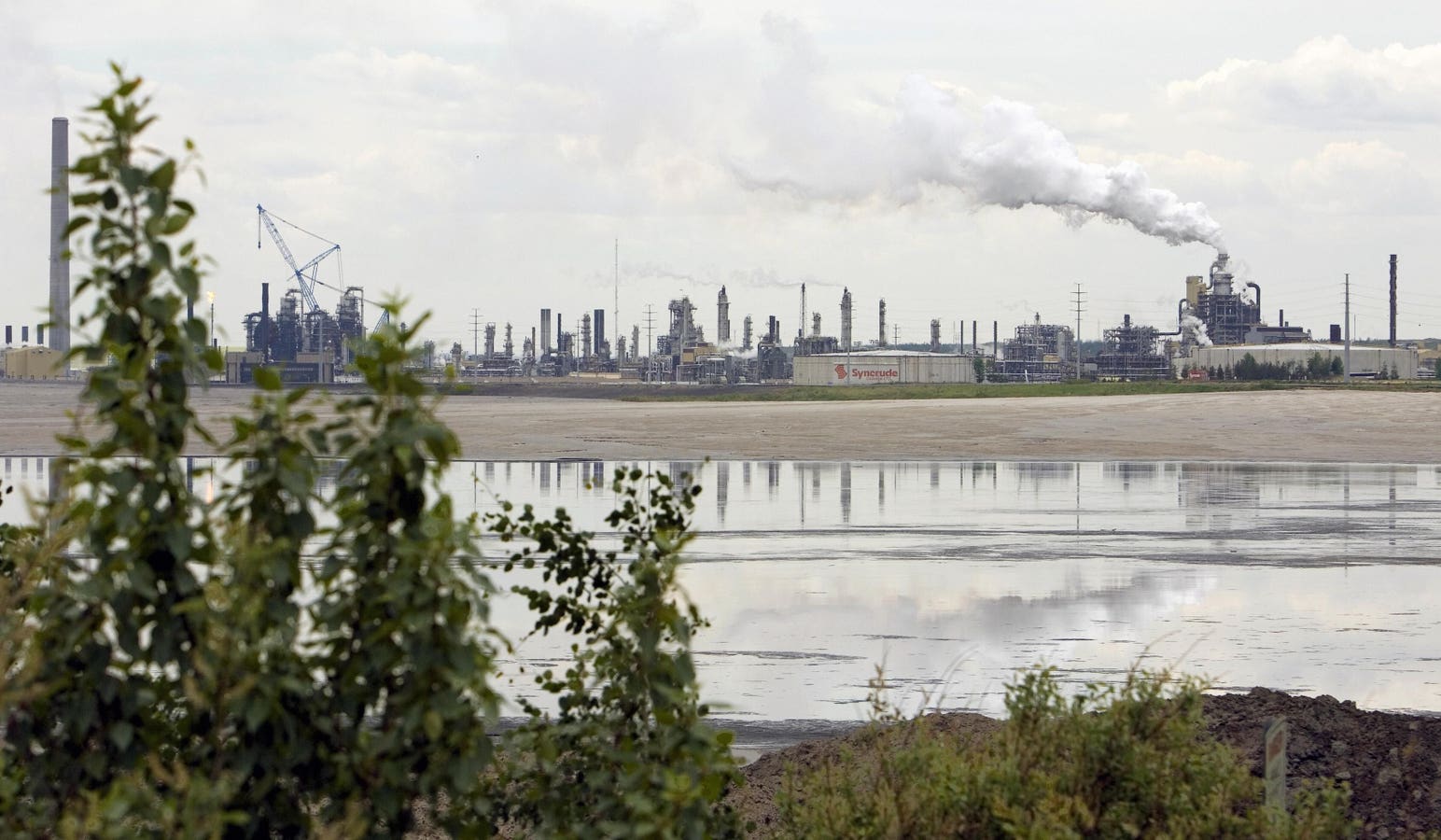Fort McMurray, CANADA: The Syncrude extraction facility in the northern Alberta oil sand fields is … [+] reflected in the pool of water being recycled for re-use in the extraction process 13 June 2007 in Fort McMurray, Canada. . AFP PHOTO/David BOILY == WITH AFP STORY: CANADA-ENERGY-OIL-TAKEOVER BY GUILLAUME LAVALLEE == (Photo credit should read DAVID BOILY/AFP via Getty Images)
AFP via Getty Images
In a previous post, I pointed out that putting tariffs on natural gas imports from Canada would raise prices to consumers in the Upper Midwest and Northwest, where there were no alternative supplies available given existing infrastructure. Bringing in new supplies would mean expanding and/or reversing existing pipelines and constructing new ones, neither of which could be done quickly. Residential gas would become more expensive, but also, electricity prices would rise and energy-intensive manufacturers would face higher costs, making them less competitive and forcing them to raise prices for their products.
Oil is a different beast, though. Most Americans know that the U.S. is a net exporter of oil due to the fracking of shale and would probably think that imports are unneeded and/or would be unaffected. And it is true that tariffs on Canadian oil would not translate into a one-for-one increase in crude prices, because the Canadian oil has to compete with other supplies. However, it would be simplistic to think that the tariffs would be paid directly by Canadian oil exporters and the import price unaffected.
Reducing the price they charge buyers to offset the tariffs is one option for Canadian producers, but another is to seek new customers, primarily by shipping oil by rail and barge to the east and west coasts (or the Great Lakes). This isn’t done now because that method of shipping is much more expensive than shipment by pipelines, $8-10/barrel versus $2-4/barrel. Transporting Oil: Why Pipelines Still Rule There is not enough rail capacity to quickly redirect the 4 million barrels a day we currently receive from Canada but given the extra $10-15/barrel producers would receive shipping to Asian customers, the incentive to do so is significant.
And the U.S. industry has many options for new crude supplies, but all would impose additional costs on the Midwest refiners who are the primary consumers of Canadian oil. Buying shale oil would certainly seem easy to do, but because shale oil is higher quality than Canadian oil, the price would be about $10/barrel more as the figure shows.
Prices for Crude Oil by Quality ($/barrel)
The author from EIA data.
And there would be losses for the industry. The figure below shows the refining margins for Midwestern refiners over the past year for a light sweet cracking refiner and a heavy sour coking refiner. The latter makes more money per barrel because it uses cheap heavy sour crude oil and turns it into more valuable light products like gasoline. The difference in margins between the two types of refineries fluctuates but is typically $5-10/barrel in favor of the heavy sour cracking unit. Putting high-quality shale oil into a coking refiner is technically feasible but economically inefficient: the crude feedstock is more expensive and you don’t get a corresponding increase in the volume of high-value products.
Midwestern Refining Margins ($/barrel)
The author from IEA data.
The other alternative is to locate more heavy sour crude to feed the Midwest refiners. Those who absorb the extra Canadian exports to Asian markets would reduce purchases of other heavy crudes, which U.S. refiners could then snap up. However, this would mean landing the crude on the Gulf Coast and shipping it by barge and/or rail, again at added expense of several dollars a barrel. Longer term, existing pipelines could be reversed, but that will take time and require operators to be confident that the tariffs won’t be removed, making their investment worthless.
As is usually the case, the answer to which option the industry will choose is ‘all of the above.’ More imports of heavy oil from overseas, some switching to more expensive, lighter fuel, and paying higher prices on the remaining Canadian crude. Paying an extra $10/barrel for crude would mean about $14 billion in annual costs, much of which would be passed on to consumers. But the costs could not be completely passed through as higher product prices in the Midwest would attract cheaper products from other regions.
So, a tariff on Canadian oil would mean that exports to the Midwest would drop, and regional prices would rise enough to attract imports of heavy oil from overseas or to make exporting Canadian oil to the Midwest more attractive than rail shipments to the coast and Asian markets. Probably Midwestern petroleum product prices would rise, with gasoline going up as much as $0.25/gallon while the industry would face losses, potentially in the billions of dollars, from less efficient operations.
So, while it is true that oil markets are much more flexible and competitive than natural gas markets, imposing tariffs on Canadian oil would have negative consequences. The virtue of free trade is that it allows industry to maximize efficiency and suddenly raising the price of one crude oil source (or two, if Mexico is also targeted) would create economic losses, some of which would be borne by the refiners in the Midwest, but much of which would be passed through to consumers. Hopefully, the threat of tariffs on Canadian and Mexican oil will be used as a negotiating chip and not ultimately imposed.
